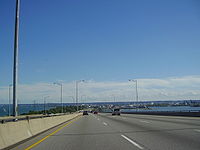Burlington Bay James N. Allan Skyway


The Burlington Bay James N. Allan Skyway, originally called the Burlington Bay Skyway, is a pair of high-level freeway bridges located in Hamilton and Burlington, Ontario, Canada. The Skyway, as it locally known, is part of the Queen Elizabeth Way (QEW) highway linking Fort Erie with Toronto.
The first bridge was completed in 1958 and officially opened 30 October 1958[1], crossing the narrow bar separating Burlington Bay from Lake Ontario. This allows for Great Lakes ship traffic to flow underneath while four lanes of Golden Horseshoe road traffic may flow on top of it, neither disturbing the other. The bridge was designed by John Turner Bell.
The bridge had tolls when constructed, but these were removed 28 December 1973[1] after they were found to heavily impede traffic flow. Truck drivers in particular had refused to take the tolled bridge since they were not only charged the full toll, but it also took them extra fuel to ascend the Skyway. With the lifting of tolls on the bridge, trucks were then banned from using Beach Boulevard.
When traffic volume became more than the bridge could accommodate in the early eighties, the bridge was twinned. When the new skyway was opened in 11 October 1985[1], traffic was temporarily rerouted to it so that the old bridge could be extensively rehabilitated and this work was completed 22 August 1988[1]. Afterwards, there were eight lanes of traffic crossing the harbour.
The twinning project also saw a major upgrade of the freeway approaches to the bridge. The entire project resulted in the QEW being widened to 8 lanes from Burlington Street to Highway 403, with modern Parclo interchanges at Burlington Street, Northshore Boulevard (former Highway 2), and Fairview Street/Plains Road. This section has a variable lighting system to overcome the frequent fog found in the area. It is also the site of Ontario's first freeway traffic management system which incorporates traffic cameras and changeable message signs.
A federally-owned low-level lift bridge linking Beach Boulevard in the Hamilton neighbourhood of Hamilton Beach and Lakeshore Road in the Burlington neighbourhood of Burlington Beach continues to operate. This is mainly used by local traffic, although ramps from the QEW have been configured to allow easy access to the bridge and re-entry to the highway, should the skyway bridge close due to high winds and adverse weather conditions, exacerbated by its towering height.
The original name of the first bridge was the Burlington Bay Skyway. After it was twinned, the proposed names of James N. Allan Skyway (in honour of the Ontario minister of highways who championed the 1958 bridge) and James N. Allan Burlington Bay Skyway were rejected. The official name since 1988 has been Burlington Bay James N. Allan Skyway.[1]
The first bridge is 36m (118 ft) high[1] and 2560m (8397 ft, 8 in) long from abatement to abatement. The second bridge is 400m (1300 ft) shorter. The skyway is 30m (97 ft) wide.[1]
See also
Images
-
Skyway Bridge
-
Skyway Bridge



